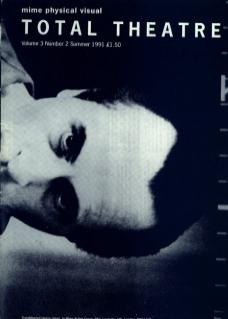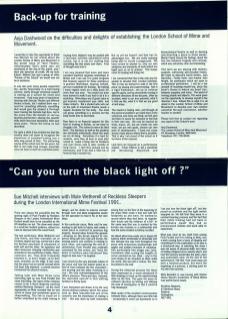There was always the possibility that the opening night of Push Parallel by Reckless Sleepers in the London International Mime Festival would have to be cancelled as the UN deadline ran out. The show went ahead to a small but riveted audience, without (as I was to discover later) the soundtrack.
The two performers, Mole Wetherell and Julie Harris, and their moveable set of furniture, teapot and cup, carried out a slow but decisive enactment of entrapment of both self and the other. An ingenious and often humorous changing relationship was embodied in the positioning of table, chairs, cupboard, etc. They were frequently hemmed in, at arm's length, up to their neck, stranded, on the edge. It was clear that the piece had an overall concept which had been fully explored – a mental universe transposed into physical actions.
Talking later with Mole threw some interesting light on how Push Parallel had come into being. The name of the company comes from a Rene Magritte painting entitled Reckless Sleepers – all the more appropriate as Mole revealed that he was active in sleep and sometimes given to sleep-walking. This link to visual art is further underlined by his initial training in design, and his desire to express concept through form and allow imaginative space for the spectator to read in his or her own ideas.
In this particular piece, Mole said he was wanting to get back to basics and create a small piece in contrast to previous big projects. Several ideas formed the genesis . drawing on the Greek legend of one person being split into male and female, the ensuing search and conflicts in relating to each other, and exploring the end of a relationship. Push Parallel was originally conceived for two actors, but ‘once the items of furniture were introduced they began to take over,’ he laughed.
I was struck by the very domestic nature of the piece and how the teapot acted as a kind of truce between the two characters – one pouring and the other receiving in a cup – the only acknowledgement of the other's presence. There was also, I learned, the desirable spin-off in that shifting furniture is thirsty work.
I was fascinated and drawn in by the very clearly defined pathway which the piece took up. Mole indicated that one of his concerns was the importance of making a trail – this was done by both characters sieving flour on the floor at the beginning of the show: Mole made a trail and Julie left footprints as she went. He wanted to record where they had been, to register their tracks and the evidence of a fall – in the same way that one is marked by the knocks one receives in a relationship and how the same incident is bitterly recalled.
He talked about how easily one is tipped off balance either emotionally or physically and this delicate line was trod throughout the piece with precarious positionings and angles and sudden reversals of situations. One particularly fine image was Julie, triumphant after scaling the heights to arrive perched on her chair – only in the next minute to be stranded as Mole undid her world. She was left in mid-air, the chair bracketed to the wall.
During the rehearsal process the ideas were expressed as a visual storyboard in little drawings to back up the experimenting done on the floor. This gave the piece its coherent structure by limiting and defining the area of investigation so that it could be fully developed.
Mole spoke of the excellent communication between them, although there was little talk – occasionally it came out backwards as in ‘can you turn the black light off’, but this posed no problem and the light switch snapped on. He felt that they were in a constant learning process and the fact that their initial training had not been in performance meant they had no preconceived notions and were able to experiment.
What was clear to me, both from seeing Push Parallel and from talking to Mole, was a work coming from a basis of integrity and commitment to the exploration of an idea in a structured way. In watching the show I was not aware of physical skills, but rather of feeling intrigued as to exactly where and how this journey would take the performers and spectators next. At the end of the performance I felt that I had come away not with a finished product, but more the beginning of a process, a starting point for my own inner journey.
Mole Benedict is now touring with Station House Oprea's production of Black Works (see performance news).

